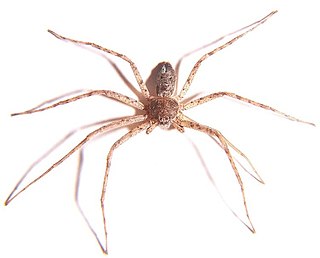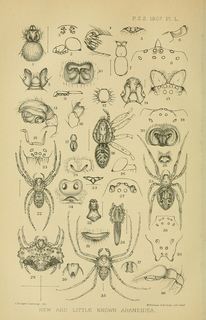
The ocelot is a wild cat native to the southwestern United States, Mexico, and Central and South America, as well as the Caribbean islands of Trinidad and Margarita. A medium-sized cat, it is characterized by solid black spots and streaks on its coat, round ears, and white neck and undersides. It weighs between 8 and 15.5 kg and reaches 40–50 cm at the shoulders. It was first described by Carl Linnaeus in 1758. Two subspecies are recognized: L. p. pardalis and L. p. mitis.

Philodromidae, also known as philodromid crab spiders and running crab spiders, is a family of araneomorph spiders first described by Tord Tamerlan Teodor Thorell in 1870. It contains over 600 species in thirty genera. Most are dull colored- brown, gray, yellowish or mottled with a leaf-like cardiac mark on the anterior dorsal abdomen, and seldom reach above 10 millimetres (0.39 in) long. None of the species build webs, but they do use silk for draglines and egg sacs.
Plecostomus, pleco, or plec is the common name of several species of freshwater loricariid catfish commonly sold as aquarium fish.

The archdukes are a genus, Lexias, of tropical forest-dwelling butterflies that are common throughout Southeast Asia and Australasia. Members of the brush-footed butterfly family Nymphalidae, the genus is represented by about 17 species. Two very similar and coexisting genera are Tanaecia and Euthalia, the latter previously including some Lexias species. The largest species reach a wingspan of about 10 cm (4 in).

The leopard tortoise is a large and attractively marked tortoise found in the savannas of eastern and southern Africa, from Sudan to the southern Cape. It is the only member of the genus Stigmochelys, although in the past it was commonly placed in Geochelone. This tortoise is a grazing species that favors semi-arid, thorny to grassland habitats. In both very hot and very cold weather they may dwell in abandoned fox, jackal, or aardvark holes. Leopard tortoises do not dig other than to make nests in which to lay eggs. Given its propensity for grassland habitats, it grazes extensively upon mixed grasses. It also favors succulents and thistles.

Deinopis, also known as net-casting spiders, gladiator spiders and ogre-faced spiders, is a genus of net-casting spiders that was first described by W. S. MacLeay in 1839. Its distribution is widely tropical and subtropical. They catch their prey using a specially spun "net". The name is derived from the Greek δεινός (deinos), meaning "fearful", and opis, meaning "appearance", referring to their ogre-like faces. The spelling "Dinopis" is also found, but is regarded as an "unjustified emendation".

The harlequin tree frog is a species of frog in the family Rhacophoridae found in Brunei, Indonesia, Malaysia, Thailand, and the Philippines. Its natural habitats are subtropical or tropical moist lowland forest, subtropical or tropical moist montane forest, freshwater marshes, and intermittent freshwater marshes. It is threatened by habitat loss.
The leopard fringe-fingered lizard, also known commonly as the Egyptian fringe-fingered lizard, is a species of lizard in the family Lacertidae. The species is endemic to North Africa.
Synodontis pardalis is a species of upside-down catfish that is endemic to Cameroon where it occurs in the Dja River drainage. It was first described by British-Belgian zoologist George Albert Boulenger in 1908, from specimens collected in the Dja River in southern Cameroon. The species name pardalis is derived from the Greek word pardalis, which means "leopard", which refers to the spotted pattern on the fish.

Pusia is a genus of sea snails, marine gastropod mollusks in the family Costellariidae.
Ophiclinops pardalis, the Spotted snakeblenny, is a species of clinids native to the coastal waters of southern Australia in seagrass beds. It can reach a maximum length of 7 centimetres (2.8 in) TL.

Pterygoplichthys pardalis, the Amazon sailfin catfish, is a freshwater tropical fish in the armored catfish family (Loricariidae). It is one of a number of species commonly referred to as the common pleco or "leopard pleco" by aquarists.
Pulchellodromus medius is a spider species found in Europe and Asia.

Pulchellodromus punctiger is a spider species found in the Canary Islands and Spain.
Pulchellodromus simoni is a spider species found in Portugal, Spain and Algeria.
Devendra pardalis, is a species of spider of the genus Devendra. It is endemic to Sri Lanka.
Devendra is a genus of Asian false wolf spiders first described by Pekka T. Lehtinen in 1967.

Zora is a genus of spiders in the family Miturgidae, subfamily Zorinae, consisting of small to medium entelegyne, ecribellate spiders. They can be identified as they have two claws with claw tufts, distinct longitudinal bands on the cephalothorax, 4-2-2 arrangement of the eight eyes and long overlapping spines on the first two tibiae and metatarsi. Their abdomens show distinct colour patterns which may be useful in identification to species. There are 17 species in the genus which have a Holarctic distribution, mostly in Europe and the Middle East but with two species in North America. The type species is Zora spinimana.
Pulchellodromus is a genus of running crab spiders that was first separated from Philodromus by J. Wunderlich in 2012.
Oligostomis pardalis is a species of giant casemaker in the family Phryganeidae. It is found in North America.









